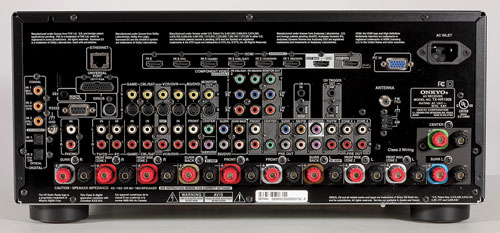Test Report: Onkyo TX-NR1008 A/V Receiver Page 2

PERFORMANCE
If the TX-NR1008 has any less real-world power capability than its predecessor, I could not detect it through listening. Two-channel, full-range stereo music sounded dynamic, clean, and satisfying. For example, Alexandre Tansman's sixth symphony, In Memoriam, played by the Melbourne Symphony (an HDTracks 88/24 download), sounded impressively transparent and nuanced via the NR1008. I was particularly struck by the wholly believable timbres and hall sound of the second movement, scored for the string orchestra alone, and by the easy, unfettered dynamics of the much busier final movement, even when played at full concert-hall level.
The 'N' in the TX-NR1008?s name stands for Network, it being equipped with wired Ethernet for audio and video streaming. (It can also access files directly via plug-in USB drives.) Servers conforming to the DLNA and Windows Media standards are supported, as are all the major audio (and video) codecs, including FLAC.
I employed TwonkyMedia, a DLNA server software run- ning in the background on my Mac, with which the Onkyo played nice, finding and playing all of my music and movie/ video files. Onscreen navigation proved faster than with many networked receivers I've used (including some earlier Onkyos), and the TX-NR1008?s genre/artist/name and alphabetic search routines made finding content, while nowhere near as rapid, visual, or fun as a dedicated music server such as those from Sonos or ReQuest (to name but two), at least possible and reasonably non-maddening.
The TX-NR1008 arrives set up with "starter" accounts for no fewer than six commercial Internet-radio services, including Pandora, Rhapsody, Slacker, and Napster, and you also can program your own direct-access feeds via any Web browser. These are a highly varied lot, of course, with individual stations ranging widely in audio quality (to say nothing of programming quality). That range extends from pretty darned good - I found plenty of 96k- and even a few 192k-bit-rate stations that sounded legitimately high fidelity - to 16k streams delivering what I imagine Uzbek State Radio must sound like via a hand-crank AM receiver set in a yurt upon the steppes.
On to movies: James Cameron's Avatar has, if noth- ing else, production values that go to 11, and the Onkyo was an enthusiastic enabler. Projected onto my 106-inch screen, the Blu-ray of course looked absolutely smashing. And while the sledgehammer plot line and summer-stock acting left me unmoved (and I make no pretense of having sat through all 160-odd minutes in sequence), Avatar's soundtrack is a Golconda of surround sound demo gems - still more stunning than its images, if possible. Even driving my comparatively low-sensitivity speaker suite, the Onkyo easily matched the enormous, all-con-suming picture on a sonic scale during the numerous full- on battle sequences with swooping, zooming copters. The DTS-HD Master Audio soundtrack was almost cloy- ingly lush, and given the full, 9.1-channel Audyssey DSX treatment, its massive, rolling ambiences and aggressive, yet sparklingly clean-sounding transients were truly dumbfounding. Wow. (I Netflixed Avatar but fear that I'm now going to have to buy a copy, adding yet another dollar or two to Jim Cameron's coffers. Dammit.)
I will note quickly that Onkyo equipped the TX-NR1008 with a full quiver of dynamics-control arrows: Audyssey Dynamic EQ and Volume, as well as THX Loudness Plus. We've covered these before, and they worked as expected here, singly and in combination. When they were enabled, low-level surround listening became more enveloping and involving (you must still choose between Dynamic EQ and Loudness Plus at setup time), and volume jumps between TV programs and commercials were effectively leveled out.
I always devote plenty of listening time to multichannel music with any new A/V receiver. The TX-NR1008 handled this segment, too, with great aplomb. The SACD edition of John Hammond's latest, Rough and Tough (Chesky), showcases the blues virtuoso (I'm a fan of nearing 40 years) solo, unplugged in a live church acoustic, and the NR1008 presented him in dramatically you-are- there fashion, with ghost-like vocal presence and beautifully balanced guitar, slide, and harp tones. Anyone who thinks multichannel music needs full orchestral or big-band material to truly strut should hear this disc.
Since the TX-NR1008 uses Faroudja DCDi silicon for its video upscaling and processing, I expected clean results, and that's what I saw. Our usual rotation of DVD and Blu-ray test discs revealed no evident shortcomings at all. Combined with the Onkyo's complete analog-to-analog and analog-to-HDMI video transcoding and extensive user settings ? these include a palette of ISF user memories - the NR1008 is an A/V receiver where the ranks near the top of its class.








































